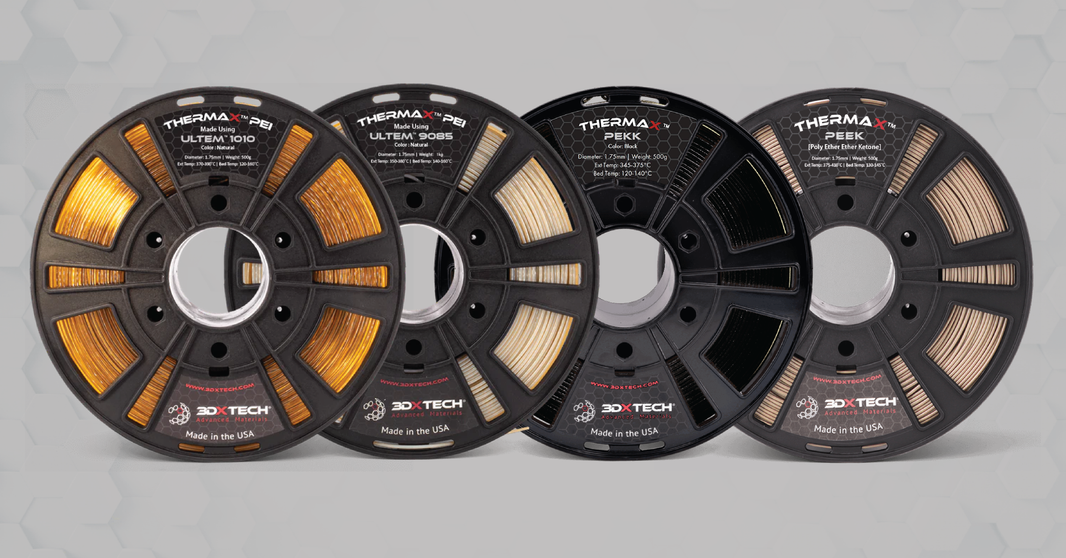Polycarbonate Filament: Strength, Reliability, and Performance for Industrial 3D Printing
Polycarbonate (PC) filament is one of the most durable and reliable engineering‑grade 3D printing materials available. Known for its high strength, impact resistance, and thermal stability, PC filament excels in aerospace, automotive, defense, manufacturing, and oil & gas environments. Whether producing functional prototypes, jigs and fixtures, or end‑use parts, PC delivers exceptional performance for industrial applications.
Benefits of Polycarbonate Filament
- Strength & Durability - With excellent impact resistance, PC parts are strong enough for production‑grade applications.
- Heat Resistance - PC maintains dimensional stability under elevated temperatures, ideal for demanding environments.
- Dimensional Accuracy - Low shrinkage and high layer adhesion help produce precise, reliable parts.
- Chemical Resistance - Resists oils, fuels, and solvents commonly found in automotive and industrial settings.
These benefits make PC filament one of the most trusted materials in industrial additive manufacturing. For applications that require fire safety, you may also be interested in our Firewire FR‑PC-ABS Filament.
Applications of Polycarbonate Filament
- Jigs, Fixtures, and Tooling — Lightweight yet strong, PC can replace machined metal tools in many cases.
- Prototypes — Functional prototypes that mimic the strength and durability of production parts.
- End‑Use Parts — Ideal for short‑run manufacturing, replacement parts, and components that must withstand heat and impact.
Working around sensitive electronics? See our guide to ESD‑Safe Filaments.
Industry Use Cases
- Aerospace — High strength‑to‑weight ratio and flame resistance for tooling, aircraft interior components, and low‑volume production parts.
- Automotive — Under‑the‑hood prototypes, lightweight fixtures, and functional end‑use components.
- Defense — Rugged housings, protective covers, and parts exposed to extreme conditions.
- Manufacturing — Strong and repeatable jigs, fixtures, and custom machine parts.
- Oil & Gas — Durable housings, inspection tools, and replacement parts exposed to harsh chemicals and elevated temperatures.
Types of Polycarbonate Filament
Carbon Fiber Reinforced Polycarbonate (PC‑CF)
Blended with chopped carbon fibers for increased stiffness, reduced warping, and lightweight strength. A top choice for aerospace and automotive applications where rigidity and weight savings matter.
ESD‑Safe Polycarbonate (PC‑ESD)
Engineered to protect sensitive electronics from electrostatic discharge. Ideal for electronics manufacturing, defense, and any environment where ESD control is critical. Learn more in our full guide to ESD‑Safe Filament.
Flame‑Retardant Polycarbonate (FR‑PC)
Formulated to meet UL94 V‑0 standards, ensuring safety compliance in aerospace, defense, and automotive interiors.
Why Choose Polycarbonate Filament for 3D Printing?
Polycarbonate bridges the gap between traditional manufacturing and industrial additive manufacturing. Its strength, heat resistance, and versatility make it an essential material for industries where safety, performance, and reliability are critical.
Whether reinforced with carbon fiber, formulated for ESD protection, or engineered for flame resistance, PC‑based filaments empower engineers and manufacturers to create the next generation of parts for aerospace, automotive, defense, manufacturing, and oil & gas applications.
FAQ: Polycarbonate Filament
What printers and settings work best with PC filament?
Use an enclosed FDM printer with a high‑temperature hotend (260–300°C), heated bed (100–120°C), and ideally a heated chamber. Dry filament at 80–90°C for 4–6 hours to minimize moisture‑related defects.
When should I choose PC‑CF over standard PC?
Choose PC‑CF when you need higher stiffness, better dimensional stability, and reduced warping. It’s especially useful for jigs, fixtures, and structural components where rigidity is key.
Is PC filament suitable for end‑use parts?
Yes—PC’s strength, heat resistance, and chemical resistance make it a strong candidate for low‑volume production and replacement parts that see real‑world loads and temperatures.
How does FR‑PC differ from standard PC?
FR‑PC includes flame‑retardant additives and is formulated to meet standards like UL94 V‑0, making it suitable for applications with strict fire safety requirements (e.g., aerospace interiors, electrical housings).






